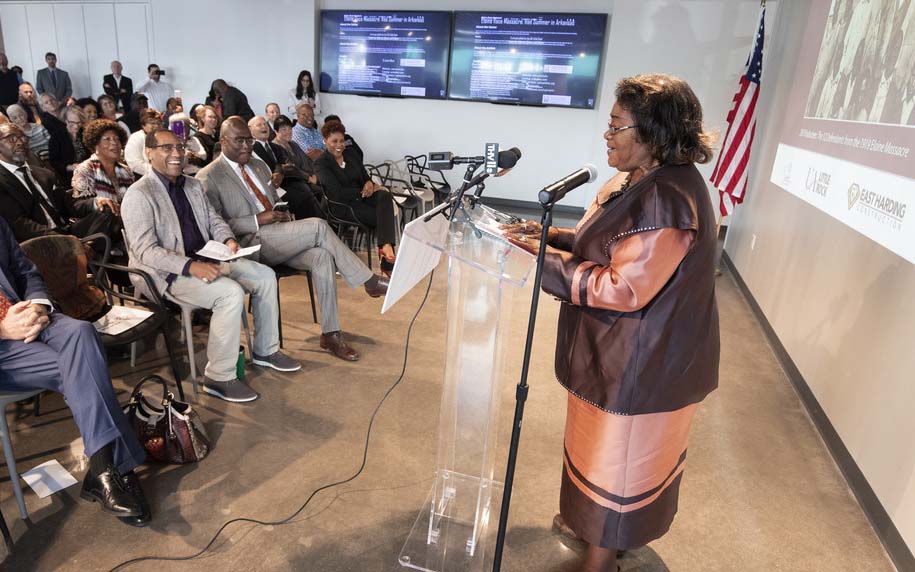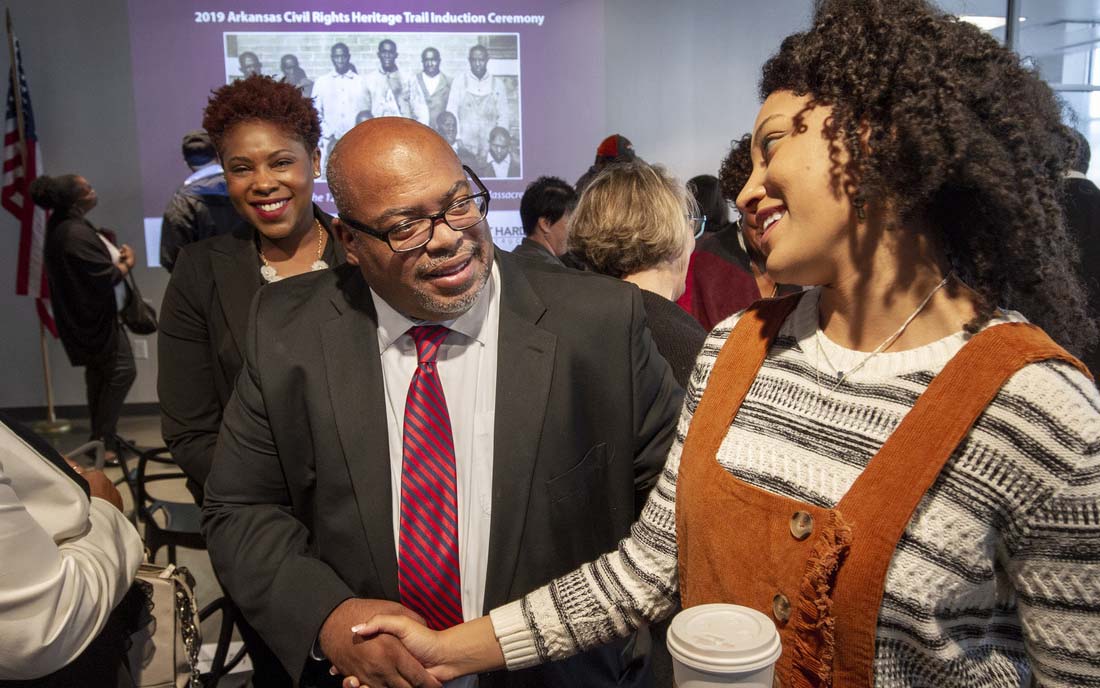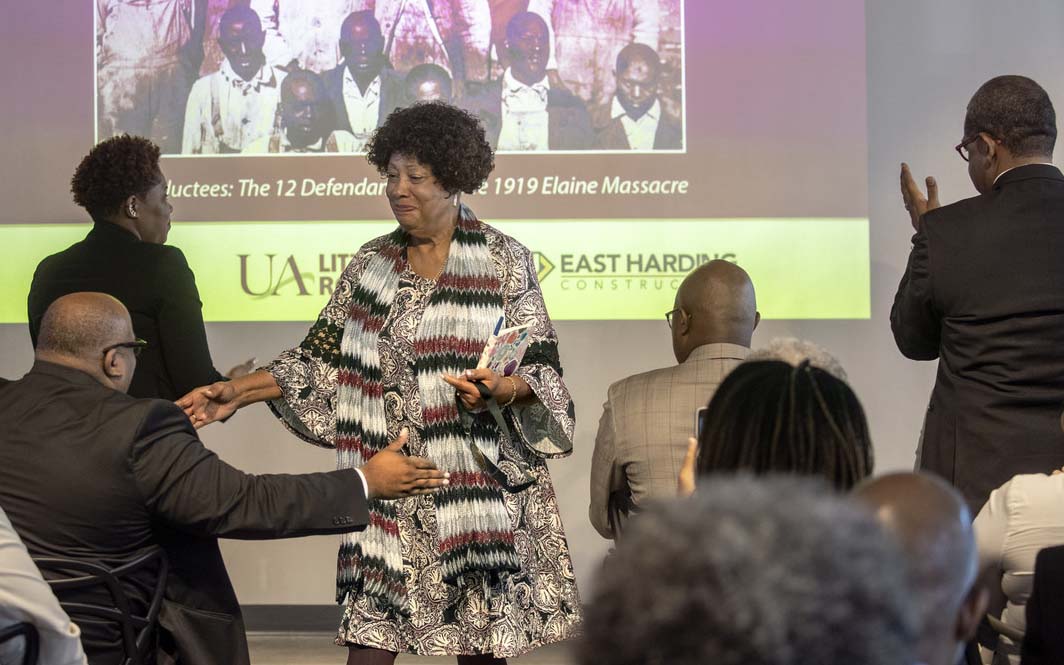Elaine 12 inducted into Arkansas Civil Rights Heritage Trail
November 25 - December 1, 2019
By Angelita Faller
This year marks the 100th anniversary of the Elaine Massacre, the deadliest racial conflict in Arkansas history, but the scars of the tragedy still follow the family members of the victims generations later.
Shelia Walker, who lives in Delaware, always knew her family held a closely guarded secret. Her great-uncle, Albert Giles, was a member of the Elaine 12, a dozen black sharecroppers in Phillips County who were wrongfully convicted of murder and sentenced to death by an all-white jury following the Elaine Massacre in 1919.
The Elaine 12 were eventually freed after the landmark Moore vs. Dempsey Supreme Court ruling in 1923. Afterwards, Giles fled Arkansas in fear of his safety and spent the rest of his life in Illinois, where he eventually was laid to rest in Springfield, far away from his family members who knew little about his life after incarceration.
“My grandmother, who was traumatized by all this, was never able to really be close to her only child, my mother, and her grandchild,” Walker said. “My family suffered because of the Elaine Massacre. The effects still carries on a generation later.”
The University of Arkansas at Little Rock inducted the now deceased members of the Elaine 12 into the Arkansas Civil Rights Heritage Trail during a ceremony at UA Little Rock Downtown on Nov. 5. The men include Giles, Alfred Banks, Ed Coleman, Joe Fox, Paul Hall, Ed Hicks, Frank Hicks, Joe Knox, John Martin, Frank Moore, Ed Ware, and William Wordlaw.
“Throughout the summer and now this fall, there have been numerous events around the state marking this important anniversary,” UA Little Rock Chancellor Christina Drale said. “It is important because telling the stories of those who lived through the incredible violence in the summer of 1919, we learn from what is now all our story.”
Lenora Marshall, member of the Elaine Quorum Court and representative of the Elaine Legacy Center, said the commemoration of the Elaine 12 means everything to the people of Elaine and allows them to talk about an event that was once considered taboo.
“It’s a tremendous move because there has been a gag order for far too long on the people of Elaine,” Marshall said. “Everyone was afraid to talk about it. Just as Little Rock has the Little Rock Nine who survived struggles, we have the Elaine 12 to raise up as civil rights heroes.”
The Elaine Massacre began Sept. 30, 1919, when representatives of the Progressive Farmers and Household Union of America met with approximately 100 African-American farmers at a church in Hoop Spur, near Elaine, to discuss unionizing. When a group of white men who learned about the meeting interrupted the discussion, two law enforcement officers were shot. A mob of an estimated 500 to 1,000 white people stormed through Phillips County, killing black men, women, and children on site. U.S. troops were called in, and the mob dispersed Oct. 2. Historians estimate that more than 200 African-American men, women, and children were murdered during the Elaine Massacre, and hundreds more were convicted of crimes in the aftermath.
“Held in concentration camps, hundreds of black sharecroppers were detained until their participation in the union could be verified,” said Kwami Abdul-Bey, co-convener of the Arkansas Peace and Justice Memorial Movement. “Scores of the union members were charged with assault, murder, and night riding. Twelve members were charged with capital murder and sentenced to death in trials that lasted no more than 20 minutes each. The total amount of time to convict them was 86 minutes.”
After the Elaine 12 were released from prison, much was left unknown about their lives. However, Dr. Brian Mitchell, assistant professor of history at UA Little Rock, has been conducting research with his students to solve mysteries surrounding the Elaine Massacre. One of the research projects included researching the post-prison lives of the Elaine 12, so that historical markers can be placed on their grave sites.
“I really want to thank my students for all their hard work,” Mitchell said. “One of the things we strive to do at UA Little Rock is prepare our students for the future. To take the study of the Elaine Massacre from obscurity to a national story has been done with the efforts of the students.”
Mitchell’s students read the names of the Elaine 12 at the induction ceremony. Four family members of the Elaine 12 accepted medallions on their behalf. They include Walker, great-niece of Albert Giles; Rev. Stephen Bradley, a relative of Ed Coleman; Dorothy Neal, granddaughter of Joe Knox; and Lisa Hicks-Gilbert, family member of Frank and Ed Hicks.
Hicks-Gilbert, who only decided to speak publicly a few days before the event, said the ceremony gave her an opportunity to break her family’s silence regarding the Elaine Massacre.
“I was very reluctant to come and speak today,” Hicks-Gilbert said. “I speak today for the Elaine 12, who changed their names and hid even from family and were never able to tell their own stories, and for my granddad, who knew of his family’s history but told my grandmother to hush and never speak of it again if asked.”
Gene Thompson, a recent history graduate of UA Little Rock who conducted research with Mitchell, felt grateful that the stories of the Elaine 12 were now in the spotlight.
“This is a story that needs to be told, and I’m glad to have been a part of telling it,” Thompson said. “The Elaine Massacre is a sad part of Arkansas history. To finally get the truth out and to be a part of that has been a thrilling experiences”
In another research project related to the Elaine Massacre, Mitchell and his students uncovered the story of Leroy Johnston, a World War I veteran who was killed with three of his brothers during the Elaine Massacre. Mitchell’s research discovered that Johnston’s medical records from World War I were altered, preventing him from receiving the military honors he deserved. Mitchell brought Johnston’s story to the attention of U.S. Rep. French Hill who worked on correcting the record. In November 2018, Johnston was posthumously awarded the Purple Heart.
“This is a momentous occasion where we honor the lives and legacy of the Elaine 12 and the other victims of that dark moment in Arkansas’s history,” Hill said. “However, history teaches us that indeed we can learn from our past and together build a better society. We wouldn’t be here if not for the work of UA Little Rock and Brian Mitchell and the extraordinary work the university has done on behalf of the Elaine Massacre.”
Following the ceremony, the new markers were unveiled on the north sidewalk of President Clinton Avenue between Cumberland Street and Rock Street. Second Presbyterian Church helped fund the markers with a $4,000 grant from the church’s Social Justice Advocacy Committee. East-Harding Construction has partnered with the university for the past 11 years to provide materials for the trail markers and install them.
Little Rock Mayor and UA Little Rock Alumnus Frank Scott, who gave closing remarks, said we must learn from the mistakes of the past to ensure that events like the Elaine Massacre are never repeated.
“We understand the Arkansas Civil Rights Heritage Trail acknowledges the past and commemorates trailblazers,” Scott said. “It honors our past but also acknowledges the horror. We thank our ancestors for what they have done. We acknowledge them, we respect them, but we give our firm commitment that it will never happen again.”
The Arkansas Civil Rights Heritage Trail was founded by the UA Little Rock Anderson Institute on Race and Ethnicity in 2011 to acknowledge the sacrifices and achievements made by those who fought for racial and ethnic justice in Arkansas. Last year, the Arkansas Civil Rights Heritage Trail was named a part of the U.S. Civil Rights Trail.
The trail begins in front of the Old State House Convention Center on Markham Street and will eventually extend to the William J. Clinton Presidential Center and Park. Each honoree’s name is commemorated with a 12-inch bronze marker on the trail and a biography on the trail’s website.
Source: UA Little Rock Communications
PHOTO CAPTIONS: (Photos by Ben Krain)
1. Elaine Legacy Center representative Lenora Marshall said the commemoration of the Elaine 12 means everything to the people of Elaine and allows them to talk about an event that was once considered taboo.
2. Dr. Brian Mitchell thanks and congratulates history students for their contributions to the Elaine 12 study.
3. Sheila Walker thanks Dr. Brian Mitchell while being honored as a descendant of the Elaine 12.





